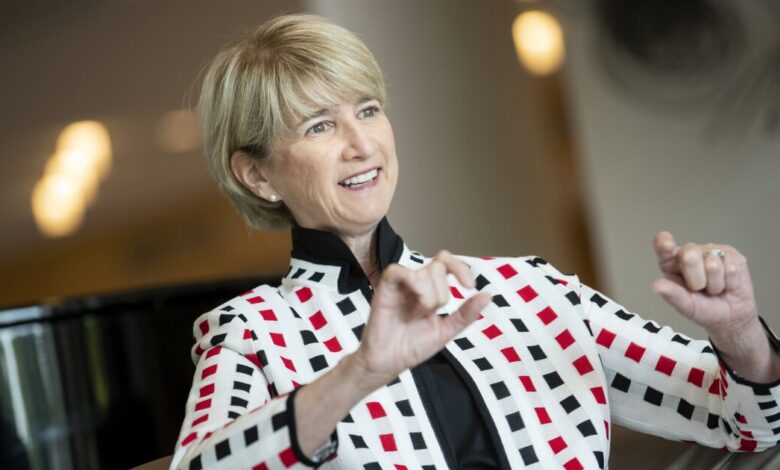Ohio State U. Unveils a Plan for All Students to Graduate Debt-Free

Nearly half of all undergraduates at Ohio State University take out loans to help pay the costs of attending college, borrowing an average of more than $27,000. Kristina M. Johnson, the new president of the land-grant university, wants to reduce that proportion to zero.
Johnson announced a plan on Friday, at her investiture, to reach that goal within a decade.
Instead of offering students federal direct loans as part of their financial-aid packages, the university will use a combination of grants, internships, and opportunities to assist with research.
“I’ve had this idea for 40 years,” said Johnson, who told The Chronicle that she might not have been able to attend graduate school if she had taken out loans to finish her undergraduate degree at Stanford University four decades ago. If Ohio State students aren’t burdened by loans, then they can more easily consider graduate school, Johnson said, or take a job because they love it, not just for the salary.
Much of the public and political discussion about student-loan debt has focused on forgiving existing loan balances. But that’s a short-term solution because in a few years a new group of students will simply accrue more debt. Ohio State is now joining the ranks of colleges seeking to solve the root cause of the problem.
Several dozen colleges across the country also promise a debt-free degree, but most are selective private universities that hold large endowments and enroll far fewer students, especially those from low- and middle-income families. The handful of large public universities that promise no-loan degrees for some undergraduates restrict those offers to low-income students to limit the expense of the program.
Ohio State’s program, called the Scarlet & Gray Advantage, will not be linked to the income of participants, so many middle-class families should also benefit. And unlike many other programs, Ohio State’s plan is meant to cover the full cost of attendance, including books, travel, and daily expenses, not just tuition and fees.
“People without family means, which includes many of the country’s minority students, start their adult lives in a financial hole,” Johnson said during her investiture speech. “I want all of our graduates to be free to say yes to every great opportunity that comes their way.”
In describing the plan, the university takes pains to point out that this will not be “free” college: Families and students will, in many cases, be expected to contribute some of their own money to the college costs. Some of that money will come from the “expected family contribution,” as defined by a federal formula when students fill out the Free Application for Federal Student Aid, the FAFSA. Students who work on campus or serve as interns will still have to apply those amounts to their university bills.
The challenges of scaling up such an effort are many, including raising nearly a billion dollars and arranging thousands of jobs for students every year. But the payoffs are also enormous, said Laura W. Perna, vice provost for faculty and a professor of education at the University of Pennsylvania. The plan’s broad design would make it easier for both low- and middle-income students to get a college education at Ohio State.
“This could create a more socioeconomically diverse student body,” she said, “which benefits everyone.”
Scaling Up
While Johnson has set a lofty goal, the program will begin in the fall of 2022 with a modest pilot serving 125 students from low- and middle-income families. The pilot will allow the university to study how the program works and avoid any unintended consequences, said Melissa L. Gilliam, executive vice president and provost at Ohio State.
For example, Gilliam said, the university doesn’t want lawmakers or the public to assume that the institution is offering the program because it is flush with cash. Another challenge, Gilliam said, is to manage the expectations of potential students, so as not to give the impression that the program will be widely available in the fall.
Those in the pilot program will be invited to campus before the start of the fall semester to help them get oriented and build community, said Melissa Shivers, senior vice president for student life at Ohio State.
As part of the requirements to participate, students will have to complete the federal application for student aid annually, commit to graduating in four years, and attend financial-literacy counseling.
The long-run challenges of the program, however, are immense. For it to reach all undergraduates within a decade, the Buckeyes will have to raise at least $800 million, including the $300 million officials expect it will cost to run the program in the short term. Officials at Ohio State have developed a detailed plan to bring the program to scale, Johnson said. That document was not made available to The Chronicle.
Veronica Meinhard, Johnson’s wife, who was a senior development official at both the University of Florida and the University of Maryland at College Park, will also play a key role in the fund-raising effort. Meinhard will not be compensated for her role.
Ohio State will also have to help arrange thousands of high-quality work experiences for students every year. A good portion of the jobs will come from doubling the number of research assistants on campus — from 2,000 to 4,000 positions annually. While some of them may be paid from a researcher’s grant money, said Gilliam, some could also be paid by the university from donations.
Work-study on campus may also be part of some students’ aid packages, Gilliam said, but the goal is to provide high-quality internship and research positions that will prepare students for graduate school or the workplace after they graduate.
Perna, at the University of Pennsylvania, said such a focus recognized that low-income students, in particular, need such experiences to succeed.
“Enabling more low-income students to participate in high-quality paid internships,” she said, “could be an effective approach to improving equity in post-college labor-market outcomes.”
The Long Run
Academics and others who study financial-aid programs say Ohio State’s plan still presents some hurdles for low-income students and plenty of unanswered questions about how it will work in the long run.
Mark Kantrowitz, a longtime expert on financial aid, said such programs don’t eliminate student-loan debt but typically do a good job of limiting both the number of students who borrow and the amounts they borrow.
While comparisons are difficult, most other colleges’ debt-free programs come with far more restrictions on eligibility.
The University of Michigan, for example, has two programs to cover tuition and fees without loans for low-income students. The Go Blue Guarantee is available only to Michigan residents whose families earn less than $65,000 a year and have assets of less than $50,000. To participate, students must fill out a FAFSA and a College Scholarship Service Profile each year to verify their income; the Ohio State program will require only the FAFSA. Michigan’s HAIL Scholarship is for students who qualify for free and reduced-price meals at public schools in the state, but the students are not required to verify incomes.
Even with those programs, nearly 28 percent of undergraduates on the Ann Arbor campus took out federal loans in the 2019-20 school year, according to federal data, borrowing an average of $6,092.
One problem that could arise from Ohio State’s plan, Kantrowitz said, is if families use loans to cover their expected contributions. And students who use wages from internships to cover college costs may still borrow money for expenses that would have been paid for with that money, he said.
“Things like this are a positive,” Kantrowitz said. “The reality is that it’s better to do this than to not.”
Another big question is whether Ohio State will continue to enroll the same kinds of students, said Nicholas Hillman, an associate professor of educational leadership and policy analysis at the University of Wisconsin at Madison. “The skeptic in me says you could go debt-free by enrolling a lot more wealthy students.”
Like other such programs, Hillman said, the importance of Ohio State’s is partly the messaging — that it’s meant to attract low- and middle-income students to college. “The spirit of this is on point,” he said.
CJ Libassi, a doctoral student at Teachers College of Columbia University and senior research associate at the Community College Research Center, said the messaging has to be personalized and unambiguous for students. “If the messaging gets muddled or there is uncertainty about whether they specifically will qualify, they will tune it out,” said Libassi.
Johnson, Ohio State’s president, explained that the program is not meant to change enrollment patterns at the university, and will be available to the broad range of students who enroll at Ohio State’s branch campuses, which are open-access, unlike the main campus, in Columbus.
“My vision,” she said, “is that students will come here and we will put them on the sharpest trajectories to become their best selves.”
Source link






